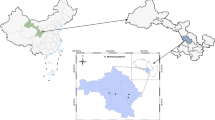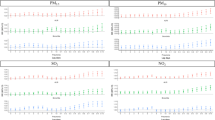Abstract
Air pollution has been a deeply concerned issue posing an immediate and profound threat to human’s lower respiratory health in China. The health of children under 5 years old, regarded as a key index of public health progress in a country, is closely related to the long-term human capital development. Hence, it is vital to investigate the potential association between air pollution and children’s lower respiratory health outcomes and to explore related policy implications regarding the public health and the pollution regulation. As air pollutants diffuse across adjacent regions rather easily, considering the spatial spillover effect is meaningful in course of acquiring the aforementioned association. Based on the proposed province-level panel dataset of China during 2006–2017, this study constructs a dynamic spatial panel Durbin model to investigate the impact of air pollution on under-five children’s lower respiratory infections. As a result, (1) both air pollution and children’s respiratory health have obvious spatial spillover effects, and the latter has an outstanding characteristic of path dependence in time. (2) In the short term, air pollution presents significant negative impact on children’s respiratory health, while in the long run, the impact decreases dramatically. (3) Regional comparison indicates that children in the western China are the most susceptible to air pollution followed by children in the central and eastern regions. (4) Other control variables have significant and varying impacts both in the short and long term. Particularly, this paper proves the existence of “siphon effect” in children healthcare system in China. From a broader and more comprehensive perspective, this study provides effective and constructive basis for policy making, in favor of improving children’s health under air pollution and promoting sustainable development in China.



Similar content being viewed by others
Data availability
The datasets are available from the corresponding author on reasonable request.
References
Asian Development Bank (ADB). (2012) Toward an environmentally sustainable future: country environmental analysis of the People’s Republic of China. https://www.adb.org/zh/publications/toward-environmentally-sustainable-future-country-environmental-analysis-peoples
Anand S, Fan V, Zhang J, Zhang L, Ke Y, Dong Z, Chen L (2008) China’s human resources for health: quantity, quality, and distribution. Lancet 372:1774–1781
Anselin L (2001) Spatial effects in econometric practice in environmental and resource economics. Am J Agr Econ 83:705–710
Anselin L, Griffith DA (1988) Do spatial effects really matter in regression analysis? Pap Reg Sci 65:11–34
Azimi M, Feng F, Zhou C (2019) Air pollution inequality and health inequality in China: an empirical study. Environ Sci Pollut Res 26(12):11962–11974
Bălă GP, Râjnoveanu RM, Tudorache E, Motișan R, Oancea C (2021) Air pollution exposure—the (in)visible risk factor for respiratory diseases. Environ Sci Pollut Res 28:19615–19628
Barreca AI (2012) Climate change, humidity, and mortality in the United States. J Environ Econ Manag 63:19–34
Beatty T, Shimshack JP (2014) Air pollution and children’s respiratory health: a cohort analysis. J Environ Econ Manag 67:39–57
Babatola SS (2018) Global burden of diseases attributable to air pollution. J Public Health Afr 9:1–12
Chen HuF, Li X, Hua J (2017a) Strategic interaction in municipal governments’ provision of public green spaces: a dynamic spatial panel data analysis in transitional China. Cities 71:1–10
Chen SS, Tian Z, Xie Z, Yin P (2017b) Impacts of air pollution and its spatial spillover effect on public health based on China’s big data sample. J Cleaner Prod 142:915–925
Chen TM, Kuschner WG, Gokhale J, Shofer S (2007) Outdoor air pollution: nitrogen dioxide, sulfur dioxide, and carbon monoxide health effects. Am J Med Sci 333:249–256
Chen Y, Schleicher N, Chen Y et al (2014) The influence of governmental mitigation measures on contamination characteristics of PM2. 5 in Beijing. Sci Total Environ 490:647–658
Crémieux PY, Meilleur MC, Ouellette P, Petit P, Zelder M, Potvin K (2005) Public and private. pharmaceutical spending as determinants of health outcomes in Canada. Health Econ 14:107–116
Cuhadaroglu B, Demirci E (1997) Influence of some meteorological factors on air pollution in Trabzon city. Energ Buildings 25:179–184
Currie J (2009) Healthy, wealthy, and wise: socioeconomic status, poor health in childhood, and human capital development. J Econ Lit 47:87–122
Currie J, Neidell M, Schmieder JF (2009) Air pollution and infant health: lessons from New Jersey. J Health Econ 28:688–703
Daniels N, Kennedy BP, Kawachi I (1999) Why justice is good for our health: the social determinants of health inequalities. Daedalus 128:215–251
Thorburn K, Darbyshire A (2009) Death by acid rain: VAP or EXIT? Crit Care 13:1–2
Ebenstein A, Fan M, Greenstone M, He G, Zhou M (2013) Evidence on the impact of sustained exposure to air pollution on life expectancy from China’s Huai River policy. P Natl Acad Sci USA 110:12936–12941
Elhorst JP (2012) Dynamic spatial panels: models, methods, and inferences. J Geogr Syst 14:5–28
Elhorst JP (2014) Spatial panel models. Springer, Berlin Heidelberg
Fan M, Guo J, Zhang M, Ebenstein A, Yin P, Greenstone M (2015) Growth, pollution, and life expectancy: China from 1991–2012. Am Econ Rev 105:226–231
Feng Y, Cheng J, Shen J, Sun H (2019) Spatial effects of air pollution on public health in China. Environ Resour Econ 73:229–250
Greenstone M, Chay K (2003) The impact of air pollution on infant mortality: evidence from geographic variation in pollution shocks induced by a recession. Q J Econ 118:1121–1167
Greenstone M, Hanna R (2014) Environmental regulations, air and water pollution, and infant mortality in India. Am Econ Rev 104:3038–3072
He G, Liu T, Zhou M (2020) Straw burning, PM2.5, and death: evidence from China. J Dev Econ 145:102–468
He G, Perloff JM (2016) Surface water quality and infant mortality in China. Econ Dev Cult Change 65:119–139
Hong-You L, Yu Q (2013) Environmental quality, public services and national health: an analysis based on cross-country data. J Fin Econ 107–119
Hy A, Yfb C, Cclb D, Yan C (2020) How does manufacturing agglomeration affect green economic efficiency? Energ Econ 92:104944
Huang Z, Zhong Z, Sha Q et al (2021) An updated model-ready emission inventory for Guangdong Province by incorporating big data and mapping onto multiple chemical mechanisms. Sci Total Environ 769:144535
IHME (2019) The Global Burden of Disease Study. http://www.healthdata.org/gbd/2019
Janke K, Propper C, Henderson J (2009) Do current levels of air pollution kill? The impact of air pollution on population mortality in England. Health Econ 18:1031–1055
Jin Q, Fang X, Wen B et al (2019) Spatio-temporal variations of PM2. 5 emission in China from 2005 to 2014. Chemosphere 183:429–436
Jones BA (2019) Infant health impacts of freshwater algal blooms: evidence from an invasive. species natural experiment. J Environ Econ Manag 96:36–59
Larssen T, Lydersen E, Tang D, He Y, Gao J, Liu H, Duan L, Seip HM, Vogt RD, Mulder J (2006) Acid Rain in China. Environ Sci Technol 40:418–425
Lesage JP, Sheng Y (2014) A spatial econometric panel data examination of endogenous versus exogenous interaction in Chinese province-level patenting. J Geogr Syst 16:233–262
Li D, Zhou Z, Si Y, Xu Y, Shen C, Wang Y, Wang X (2018) Unequal distribution of health human resource in mainland China: what are the determinants from a comprehensive perspective? Int J Equity Health 17:1–12
Li L, Qian J, Ou C, Zhou YX, Guo C, Guo Y (2014) Spatial and temporal analysis of air pollution index and its timescale-dependent relationship with meteorological factors in Guangzhou, China, 2001–2011. Environ Pollut 190:75–81
Li J, Li S (2020) Energy investment, economic growth and carbon emissions in China—empirical analysis based on spatial Durbin model. Energy Policy 140:111425
Liu L, Oza S, Hogan D, Chu Y, Perin J, Zhu J, Lawn JE, Cousens S, Mathers C, Black RE (2016) Global, regional, and national causes of under-5 mortality in 2000–15: an updated systematic analysis with implications for the Sustainable Development Goals. Lancet 388:3027–3035
Ministry of ecology and environment, the Peoples Republic of China (2020) Brief introduction of China’s ecological environment quality. http://english.mee.gov.cn/. Accessed Dec 2020
Pan J, Liu G, Gao C (2013) How does separating government regulatory and operational control of public hospitals matter to healthcare supply? China Econ Rev 27:1–14
Poon JPH, Casas I, He C (2006) The impact of energy, transport, and trade on air pollution in China. Eurasian Geogr Econ 47:568–584
Pope CA, Schwartz J, Ransom MR (1992) Daily mortality and PM10 pollution in Utah Valley. Arch Environ Health 47:211–217
Shaman J, Kohn M (2009) Absolute humidity modulates influenza survival, transmission, and seasonality. P Natl Acad Sci USA 106:3243–3248
Shi M, Ma G, Yong S (2011) How much real cost has China paid for its economic growth? Sustain Sci 6:35–149
Sui D (2004) Tobler’s first law of geography: a big idea for a small world? Annals of the Assoc Am Geogr 94:269–277
Troeger CE (2020) Quantifying risks and interventions that have affected the burden of lower respiratory infections among children younger than 5 years: an analysis for the Global Burden of Disease Study 2017. Lancet 20:60–79
Torres P, Ferreira J, Monteiro A, Costa S, Pereira MC, Madureira J, Teixeira JP (2018) Air pollution: a public health approach for Portugal. Sci Total Environ 643:1041–1053
Uriarte M, Yackulic CB, Cooper T et al (2009) Expansion of sugarcane production in São Paulo, Brazil: implications for fire occurrence and respiratory health. Agr Ecosyst Environ 132:48–56
Wang K-L, Miao Z, Zhao MS, Miao CL, Wang QW (2019) China’s provincial total-factor air pollution emission efficiency evaluation, dynamic evolution and influencing factors. Ecol Indic 107:105578
Wang X (2020) Global burden of respiratory infections associated with seasonal influenza in children under 5 years in 2018: a systematic review and modelling study. Lancet Glob Health 8:497–510
Wu X, Nethery RC, Sabath MB, Braun D, Dominici F (2020) Air pollution and COVID-19 mortality in the United States: strengths and limitations of an ecological regression analysis. Sci adv 6:eabd4049
Xiu G, Li Y, Yu J (2016) Characteristics of haze pollution episodes and analysis of a typical winter haze. process in Shanghai. Aerosol Air Qual Res 16:1625–1637
Xu H, Cao J, Chow JC et al (2016) Inter-annual variability of wintertime PM2. 5 chemical composition. in Xi’an, China: evidences of changing source emissions. Sci Total Environ 545:546–555
Yin C, He Q, Liu Y, Chen W, Gao Y (2018) Inequality of public health and its role in spatial. accessibility to medical facilities in China. Appl Geogr 92:50–62
Yang T, Liu W (2018) Does air pollution affect public health and health inequality? Empirical evidence from China. J Clean Prod 203:43–52
Yan-Ran Q, Fan Y (2016) Spatial linkage analysis of the impact of regional economic activities on PM2.5 pollution in China. J Clean Prod 139:1157–2116
Yang G (2013) Rapid health transition in China, 1990–2010: findings from the Global Burden of Disease Study 2010. Lancet 381:1987–2015
You W, Lv Z (2018) Spillover effects of economic globalization on CO2 emissions: a spatial panel approach. Energ Econ 73:248–257
Zeng J, He Q (2019) Does industrial air pollution drive health care expenditures? Spatial evidence from China. J Clean Prod 218:400–408
Author information
Authors and Affiliations
Contributions
Material preparation and data collection were performed by Yi Chen; results analysis was conducted by Yongna Yao, Yining Yang, and Xuehao Wang. The manuscript was revised by Zhongwen Xu, and all authors commented on previous versions of the manuscript.
Corresponding author
Ethics declarations
Ethics approval
No ethics related information.
Consent to participate
I am free to contact any of the people involved in the research to seek further clarification and information.
Consent for publication
This manuscript has not been published or presented elsewhere in part or in entirety and is not under consideration by another journal.
Competing interests
The authors declare no competing interests.
Additional information
Responsible Editor: Lotfi Aleya
Publisher's note
Springer Nature remains neutral with regard to jurisdictional claims in published maps and institutional affiliations.
Rights and permissions
About this article
Cite this article
Chen, Y., Yang, Y., Yao, Y. et al. Spatial and dynamic effects of air pollution on under-five children’s lower respiratory infections: an evidence from China 2006 to 2017. Environ Sci Pollut Res 29, 25391–25407 (2022). https://doi.org/10.1007/s11356-021-17791-x
Received:
Accepted:
Published:
Issue Date:
DOI: https://doi.org/10.1007/s11356-021-17791-x




